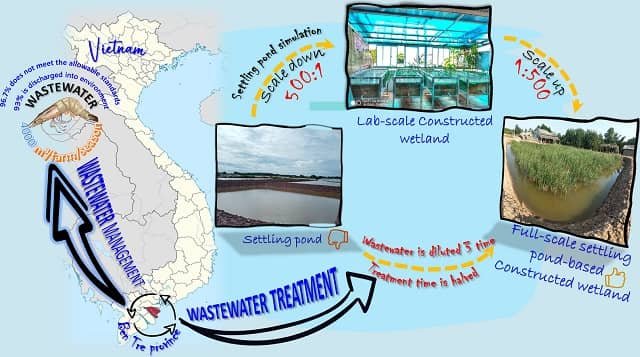
The thriving shrimp farming industry, a vital source of income and foreign exchange, faces a critical challenge: pollution. Untreated water discharges from shrimp ponds not only harm the environment but also threaten the long-term sustainability of this crucial economic driver.
But there is hope on the horizon, in the form of a simple yet effective technology: artificial wetlands, also known as constructed wetlands, which are a type of biological treatment.
Researchers from Ho Chi Minh City University of Natural Resources and Environment and Duy Tan University designed and built a laboratory-scale artificial wetland to validate the effectiveness of the constructed wetland approach.
The problem: contaminated aquatic ecosystems and unsustainable practices
Shrimp farms, despite their economic benefits, discharge large amounts of untreated wastewater. This cocktail of chemicals, organic matter, and nutrients “feeds” eutrophication, disrupts aquatic ecosystems, and jeopardizes both the future of shrimp farming and the health of surrounding ecosystems. Current treatment methods, often relying on expensive and environmentally harmful chemicals, are not the answer.
The researchers reported surveying 30 shrimp farms in the Ben Tre province (Vietnam), and the results were surprising: 96.7% of discharged water from shrimp ponds does not meet basic standards, and, worse, over 90% of this contaminated water is directly released into the environment.
Artificial wetland: a nature-based solution
To address this challenge, researchers propose a natural and affordable solution: constructed wetlands built with “reed” plants (Phragmites australis and Phragmites vallatoria) and existing sedimentation ponds. Imagine a series of ponds filled with these beneficial plants, acting as biological filters to naturally purify the water.
Constructed wetlands are systems that mimic nature, filled with plants, bacteria, and other organisms that naturally purify water. They are cost-effective, environmentally friendly, and easy to maintain: perfect for shrimp farmers with limited resources. But are they effective?
Testing artificial wetlands
This study investigates the potential of artificial wetlands as a viable solution for treating water from shrimp ponds in the Mekong Delta, the heart of shrimp farming in Vietnam. The researchers’ strategy was:
- Evaluate discharge practices and wastewater quality at 30 farms.
- Construct a laboratory-scale artificial wetland model using real pond water to test its effectiveness, at a rate of 25 plants per square meter of P. vallatoria.
- Explore the short-term treatment viability of the artificial wetland for continuous water supply in super-intensive aquaculture.
- Estimate the cost-effectiveness of using constructed wetlands in the context of the Mekong Delta.
Promising results
In just 4 weeks, the artificial wetland transformed contaminated water into clean water, meeting all environmental standards. The efficiency was impressive, removing up to:
- 80% of organic matter
- 85% of nutrients
- 91% of heavy metals
- 41% of total coliform bacteria.
Application in the shrimp industry
But could this “magic” translate to real-world farms? Absolutely!
When scientists tested the full-scale wetland, removal efficiencies increased in certain categories, and even better news: treatment time was significantly reduced.
Diluting wastewater 1.5 times and 3 times allowed clean water production in just 3 and 2 weeks, respectively. This opens the door for the intensification of semi-intensive operations that may require more frequent water exchanges, as artificial wetlands can meet the demand.
The study results could transform the Vietnamese shrimp industry, and beyond, as constructed wetlands offer a practical, affordable, and eco-friendly solution that:
- Protects the environment: minimizing water pollution.
- Increases shrimp farmers’ income by allowing intensive and super-intensive practices.
Conclusion
Preliminary study results are promising and suggest that constructed wetlands can significantly improve water quality and reduce pollution.
According to the study authors, using a sedimentation pond is ideal for building an artificial wetland because it saves construction costs and is highly effective in treating shrimp pond wastewater.
This research is not just about clean water; it’s about building a better future for Vietnamese shrimp producers, their communities, and the fragile ecosystems relying on clean water. Constructed wetlands offer a simple, affordable, nature-based solution that can revolutionize shrimp farming and ensure a sustainable future for generations to come. However, it’s also important to highlight that there are alternatives to valorize aquaculture effluents.
The study was funded by the “Provincial Strategy on R&D and Application of Technology” of Ben Tre province (Vietnam) and Duy Tan University.
Contact
Hien Y. Hoang
Center for Advanced Chemistry, Institute of Research and Development
Duy Tan University
03 Quang Trung, Danang 550000, Viet Nam.
Email: hoanghieny@duytan.edu.vn
Reference
That, L. T., & Hoang, H. Y. (2024). Utilizing a settling pond-based constructed wetland for the treatment of shrimp aquaculture wastewater–From laboratory to field scale: A case study in Ben Tre Province, Vietnam. Ecological Engineering, 199, 107172.
Editor at the digital magazine AquaHoy. He holds a degree in Aquaculture Biology from the National University of Santa (UNS) and a Master’s degree in Science and Innovation Management from the Polytechnic University of Valencia, with postgraduate diplomas in Business Innovation and Innovation Management. He possesses extensive experience in the aquaculture and fisheries sector, having led the Fisheries Innovation Unit of the National Program for Innovation in Fisheries and Aquaculture (PNIPA). He has served as a senior consultant in technology watch, an innovation project formulator and advisor, and a lecturer at UNS. He is a member of the Peruvian College of Biologists and was recognized by the World Aquaculture Society (WAS) in 2016 for his contribution to aquaculture.
